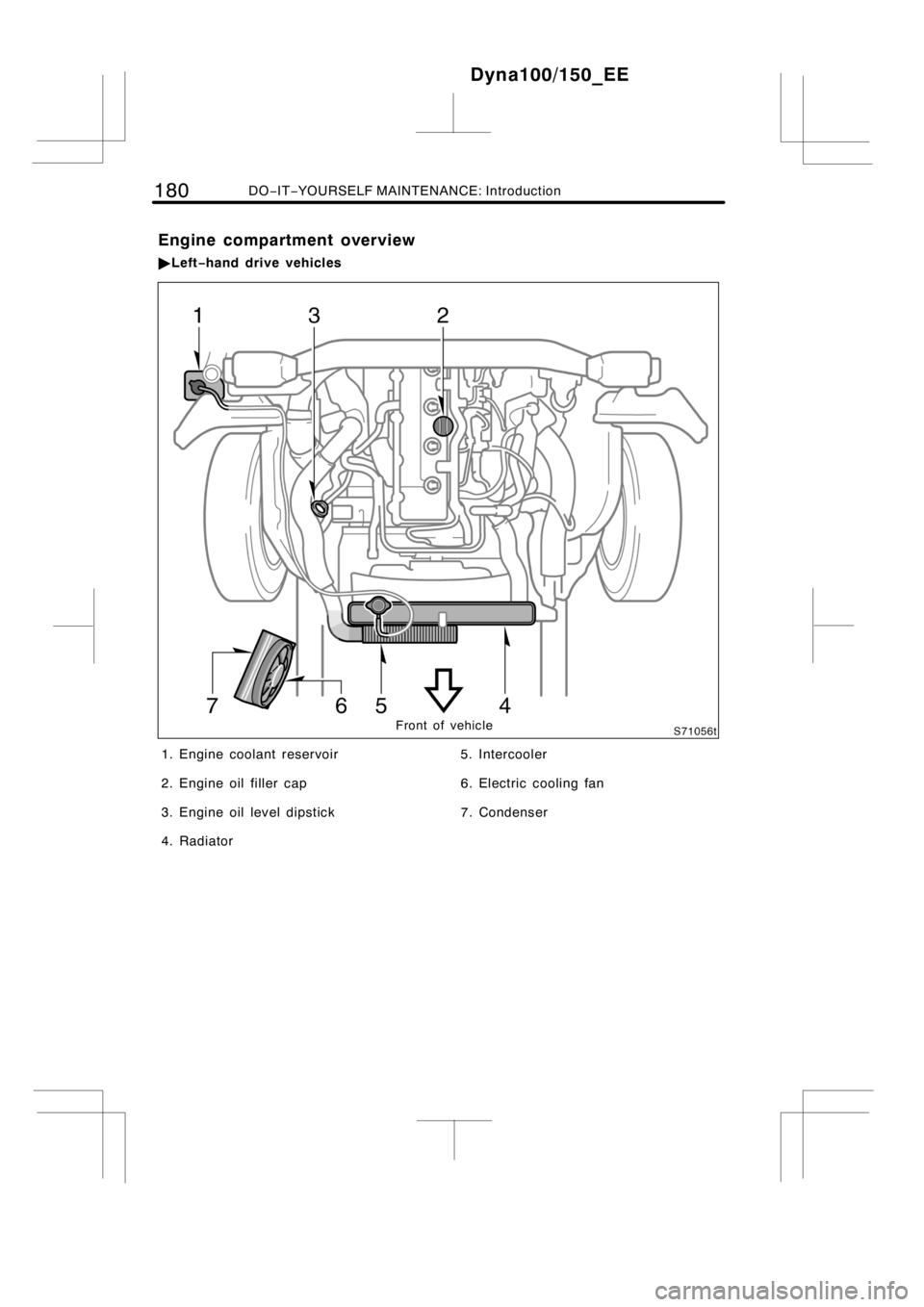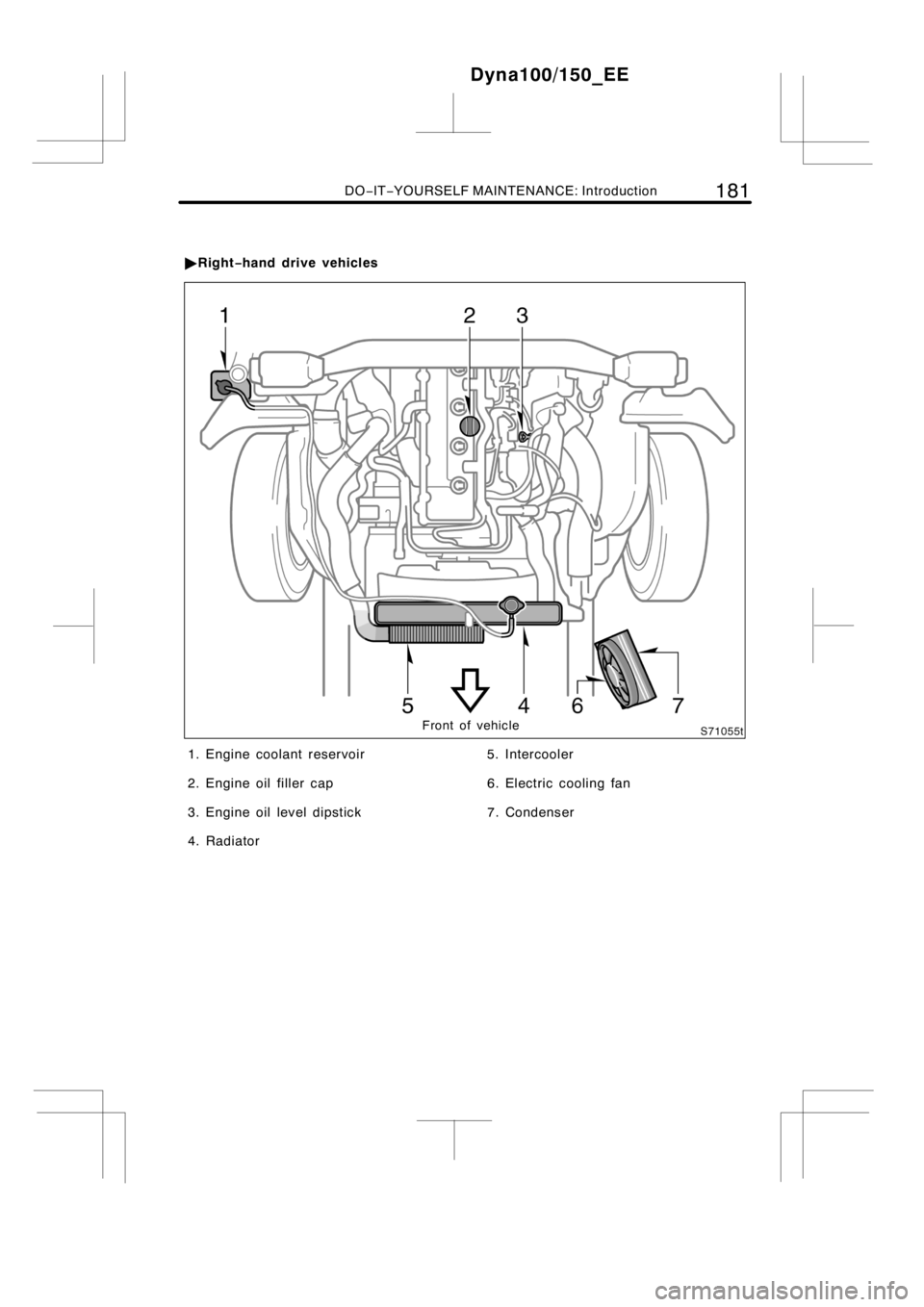2014 TOYOTA DYNA 100/150 engine coolant
[x] Cancel search: engine coolantPage 143 of 232

STARTING AND DRIVING137
DBacking with a trailer is difficult and
requires practice. Grip the bottom of
the steering wheel and move your hand
to the left to move the trailer to the
left. Move your hand to the right to
move the trailer to the right. (This pro-
cedure is generally opposite to that
when backing without a trailer.) Also,
just turn the steering wheel a little at
a time, avoiding sharp or prolonged
turning. Have someone guide you when
backing to reduce the risk of an acci-
dent.
DRemember that when making a turn,
the trailer wheels will be closer than
the vehicle wheels to the inside of the
turn. Therefore, compensate for this by
making a larger than normal turning
radius with your vehicle.
DCrosswinds and rough roads will ad-
versely affect handling of your vehicle
and trailer, causing sway. Pay attention
to the rear from time to time to pre-
pare yourself for being passed by large
trucks or buses, which may cause your
vehicle and trailer to sway. If swaying
happens, firmly grip the steering wheel
and reduce speed immediately but
gradually. Never increase speed. If it is
necessary to reduce speed, brake
slowly. Steer straight ahead. If you
make no extreme correction with the
steering or brakes, the vehicle and
trailer will stabilize.
DBe careful when passing other ve-
hicles. Passing requires considerable
distance. After passing a vehicle, do
not forget the length of your trailer and
be sure you have plenty of room be-
fore changing lanes.
DTo maintain engine braking efficiency,
when using engine braking, do not use
fifth gear.
DBecause of the added load of the trail-
er, your vehicle’s engine may overheat
on hot days (at temperatures over
30_C[85_F]) when going up a long or
steep grade with a trailer. If the engine
coolant temperature gauge indicates
overheating, pull off the road and stop
in a safe spot. Refer to “If your vehicle
overheats” on page 148 in Section 4.
DAlways place wheel blocks under both
the vehicle and trailer wheels when
parking. Apply the parking brake firmly.
Put the transmission in first or reverse.
Avoid parking on a slope with a trailer,
but if it cannot be avoided, do so only
after performing the following:
1. Apply the brakes and hold.
2. Have someone place wheel blocks un-
der both the vehicle and trailer wheels.
3. When the wheel blocks are in place,
release your brakes slowly until the
blocks absorb the load.
4. Apply the parking brake firmly.
5. Shift into first or reverse and turn off
the engine.
When restarting out after parking on a
slope:
1. With the clutch pedal depressed, start
the engine.
2. Shift into gear.
3. Release the parking brake and slowly
pull or back away from the wheel
blocks. Stop andapply your brakes.
4. Have someone retrieve the blocks.
Dyna100/150_EE
Page 154 of 232

148IN CASE OF AN EMERGENCY
If your engine coolant temperature
gauge indicates overheating, if you ex-
perience a loss of power, or if you hear
a loud knocking or pinging noise, the
engine has probably overheated. You
should follow this procedure...
1. Pull safely off the road, stop the ve-
hicle, and turn on your emergency
flashers. Put the transmission in neu-
tral and apply the parking brake. Turn
off the air conditioning if it is being
used.
2. If coolant or steam is boiling out of the
radiator or reservoir, stop the engine.
Wait until the steam subsides before
opening the engine access hole cover
or tilting the cab. If there is no coolant
or steam boiling over, leave the engine
running and make sure the electric
cooling fan is operating. If it is not,
turn the engine switch off.
CAUTION
To help avoid serious injury, keep the
engine access hole cover closed or
the cab lowered until there is no
steam. Escaping steam or coolant is
a sign of very high pressure.
3. Visually check to see if the engine
drive belt (fan belt) is broken or loose.
Look for obvious coolant leaks from the
radiator, hoses, and under the vehicle.
However, note that water draining from
the air conditioning is normal if it has
been used.
CAUTION
When the engine is running, keep
hands and clothing away from the
moving fan and engine drive belts.
4. If the engine drive belt is broken or the
coolant is leaking, stop the engine im-
mediately. Call any authorized Toyota
dealer or repairer, or another duly qual-
ified and equipped professional, for as-
sistance.
5. If the engine drive belt is O.K. and
there are no obvious leaks, you may
help the engine cool down more quickly
by running it at about 1500 rpm for a
few minutes with the accelerator pedal
lightly depressed.
6. Check the coolant reservoir. If it is dry,
add coolant to the reservoir while the
engine is running. Fill it about half full.
For the coolant type, see “Coolant type
selection” on page 191 in Section 7−2.
CAUTION
Do not attempt to remove the radiator
cap when the engine and radiator are
hot. Serious injury could result from
scalding hot fluid and steam blown
out under pressure.
7. After the engine coolant temperature
has cooled to normal, again check the
coolant level in the reservoir. If neces-
sary, bring it up to half full again.
Serious coolant loss indicates a leak in
the system. You should have it
checked as soon as possible at any
authorized Toyota dealer or repairer, or
another duly qualified and equipped
professional.
Dyna100/150_EE
If your vehicle overheats
Page 183 of 232

MAINTENANCE REQUIREMENTS177
Note, however, that some maintenance
tasks require special tools and skills.
These are best performed by qualified
technicians. Even if you’re an experienced
do−it−yourself mechanic, we recommend
that repairs and maintenance be con-
ducted by an authorized Toyota dealer or
repairer, or another duly qualified and
equipped professional. Any authorized
Toyota dealer or repairer will keep a
record of maintenance, which could be
useful should you ever require Warranty
Service. Should you choose to select a
qualified and equipped professional other
than an authorized Toyota repairer to
service or maintain your vehicle, we
recommend that you request that a record
of maintenance be kept.
The service interval for scheduled main-
tenance is determined by the odometer
reading or time interval, whichever
comes first, shown in the schedule.
Rubber hoses (for cooling and heater
system, brake system and fuel system)
should be inspected by a qualified tech-
nician in accordance with the Toyota
maintenance schedule.
They are particularly important mainte-
nance items. Have any deteriorated or
damaged hoses replaced immediately.
Note that rubber hoses will deteriorate
with age, resulting in swelling, chafing or
cracks.Be on the alert for changes in perfor-
mance, sounds, and visual tip−offs that
indicate service is needed. Some impor-
tant clues are as follows:
DEngine missing, stumbling, or pinging
DAppreciable loss of power
DStrange engine noises
DA leak under the vehicle (However, wa-
ter dripping from the air conditioning
after use is normal.)
DChange in exhaust sound (This may
indicate a dangerous carbon monoxide
leak. Drive with the windows open and
have the exhaustsystem checked im-
mediately.)
DFlat−looking tire; excessive tire squeal
when cornering; uneven tire wear
DVehicle pulls to one side when driving
straight on a level road
DStrange noises related to suspension
movement
DLoss of brake effectiveness; spongy
feeling brake or clutch pedal; pedal al-
most touches floor; vehicle pulls to one
side when braking
DEngine coolant temperature continually
higher than normal
If you notice any of these clues, take your
vehicle to any authorized Toyota dealer or
repairer, or another duly qualified and
equipped professional, as soon as pos-
sible. It probably needs adjustment or re-
pair.
CAUTION
Do not continue driving with the ve-
hicle unchecked. It could result in se-
rious vehicle damage and possibly se-
rious injury.
Dyna100/150_EE
Does your vehicle need
repairing?
Page 186 of 232

180DO−IT−YOURSELF MAINTENANCE: Introduction
Front of vehicle
1. Engine coolant reservoir
2. Engine oil filler cap
3. Engine oil level dipstick
4. Radiator5. Intercooler
6. Electric cooling fan
7. Condenser
Dyna100/150_EE
Engine compartment overview
"Left−hand drive vehicles
Page 187 of 232

DO−IT−YOURSELF MAINTENANCE: Introduction181
Front of vehicle
1. Engine coolant reservoir
2. Engine oil filler cap
3. Engine oil level dipstick
4. Radiator5. Intercooler
6. Electric cooling fan
7. Condenser
Dyna100/150_EE
"Right−hand drive vehicles
Page 191 of 232

DO−IT−YOURSELF MAINTENANCE: Introduction185
If you perform maintenance by yourself,
be sure to follow the correct procedure
given in this Section.
You should be aware that improper or in-
complete servicing may result in operating
problems.
This Section gives instructions only for
those items that are relatively easy for an
owner to perform. As explained in Section
6, there are still a number of items that
must be done by a qualified technician
with special tools.
Utmost care should be taken when work-
ing on your vehicle to prevent accidental
injury. Here are a few precautions that
you should be especially careful to ob-
serve:
CAUTION
DWhen the engine is running, keep
hands, clothing, and tools away
from the moving fan and engine
drive belts. (Removing rings,
watches, and ties is advisable.)
DRight after driving, the engine
compartment—the engine, radiator,
exhaust manifold and power steer-
ing fluid reservoir, etc.—will be hot.
So be careful not to touch them.
Oil and fluids may also be hot.
DIf the engine is hot, do not remove
the radiator cap or loosen the drain
plugs to prevent burning yourself.
DDo not leave anything that may
burn easily, such as paper or rags,
in the engine compartment.
DDo not smoke, cause sparks or al-
low open flames around fuel or the
battery. Their fumes are flammable.
DBe extremely cautious when work-
ing on the battery. It contains poi-
sonous and corrosive sulfuric acid.
DDo not get under your vehicle with
just the body jack supporting it. Al-
ways use automotive jack stands or
other solid supports.
DBe sure that the engine switch is
off if you work near the electric
cooling fans. With the engine
switch on, the electric cooling fans
will automatically start to run if the
engine coolant temperature is high
and/or the air conditioning is on.
DUse eye protection whenever you
work on or under your vehicle
where you may be exposed to flying
or falling material, fluid spray, etc.
DUsed engine oil contains potentially
harmful contaminants which may
cause skin disorders such as in-
flammation or skin cancer, so care
should be taken to avoid prolonged
and repeated contact with it. To re-
move used engine oil from your
skin, wash thoroughly with soap
and water.
DDo not leave used oil within the
reach of children.
DDispose of used oil and filter only
in a safe and acceptable manner.
Do not dispose of used oil and fil-
ter in household trash, in sewers or
onto the ground. Call your dealer or
a service station for information
concerning recycling or disposal.
DTake care when filling the brake and
clutch fluid reservoirs because
brake fluid can harm your hands or
eyes. If fluid gets on your hands or
in your eyes, flush the affected area
with clean water immediately. If you
still feel uncomfortable with your
hands or eyes, go to the doctor.
Dyna100/150_EE
Do−it−yourself service
precautions
Page 192 of 232

186DO−IT−YOURSELF MAINTENANCE: Introduction
NOTICE
zRemember that battery cables carry
high currents. Be careful of acci-
dentally causing a short circuit.
zAdd only “Toyota Super Long Life
Coolant” or similar high quality eth-
ylene glycol based non−silicate,
non−amine, non−nitrite, and non−bo-
rate coolant with long−life hybrid
organic acid technology to fill the
radiator. “Toyota Super Long Life
Coolant” is a mixture of 50% cool-
ant and 50% deionized water.
zIf you spill some of the coolant, be
sure to wash it off with water to
prevent it from damaging the parts
or paint.
zDo not overfill power steering fluid,
or the power steering could be
damaged.
zIf you spill brake fluid, be sure to
wash it off with water to prevent it
from damaging the parts or paint.
zDo not drive with the air cleaner
filter removed, or excessive engine
wear could result.
zBe careful not to scratch the glass
surface with the wiper frame.
zWhen closing the engine access
hole cover or lowering the cab,
check to see that you have not for-
gotten any tools, rags, etc.
Dyna100/150_EE
Page 193 of 232

DO−IT−YOURSELF MAINTENANCE: Engine and Chassis187
Section 7−2
DO−IT−YOURSELF MAINTENANCE
Engine and Chassis
DChecking the engine oil level 188........................
DChecking the engine coolant level 190...................
DChecking the radiator, condenser and intercooler 192.....
DDraining fuel filter water 192............................
DChecking tire inflation pressure 193.....................
DChecking and replacing tires 194........................
DRotating tires 195......................................
DInstalling snow tires and chains 196.....................
DReplacing wheels 197..................................
Dyna100/150_EE